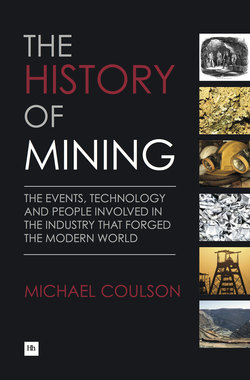Читать книгу The History of Mining - Michael Coulson - Страница 17
На сайте Литреса книга снята с продажи.
Greece
ОглавлениеOne of the most famous mines of the Iron Age was the great silver and lead operation at Laurion, a few miles south of Athens, developed in the 5th century BC. Greece was a major area for silver mining and its coinage and regional wealth was based on the metal. In this it was different from Egypt and indeed also from rival Persia, both of whose wealth was built on gold. Gold was also the financial key to Rome’s wealth and power later. Laurion was originally worked in the 2nd millennium BC but really came into its own under the Greeks, whose main sources of silver in northern Greece had been cut off by the Persians in 512 BC.
The Laurion mines were first worked as shallow pits going down no more than a few feet. In due course the Greeks started sinking shafts and as many as 2000 have been identified at the ancient site. The shafts were sunk in pairs and with multiple crosscuts, which also aided ventilation. As the shaft system deepened it was joined together by drifts and the shafts themselves went down as much as 300 feet; it has been calculated that progress could have been at a rate of 5 feet a month. However, it is important to remember that both shaft sinking and mining was spread over several centuries so the relatively slow shaft-sinking rate was not really a handicap in economic terms.
At 300 feet the ancient miners, many of them slaves, would have reached the water table inhibiting further shaft deepening. The shafts themselves were well-constructed, often perpendicular and around 6 feet by 3 feet in diameter. The mining method was fairly rudimentary but since this was now the Iron Age the mining tools were often picks and chisels of wrought iron, which were more effective than the old stone implements used previously. Underground the drifts followed the veins of ore and galleries supported by un-mined rock pillars provided the miners with enough room to prise the ore from the rock.
Once the ore had been mined it was carried to the surface where it was crushed and then washed on grooved tables allowing the metal grains to be caught in the grooves and the waste crushed rock to be washed away. Since the mine was in a dry region, water was precious and the Greeks stored their water for washing the ore in tanks built into the hillside. They also recycled used water back into the tanks after the treatment sludge had been removed in settling basins. The remaining concentrate was treated in small furnaces to free the silver and then fired again in clay crucibles, which allowed the lead to oxidise forming a disposable slag and leaving behind pure silver. The Greeks may have been cruel taskmasters when it came to the conditions under which their slave miners worked, but these mining techniques nonetheless displayed technically advanced knowledge.
The Laurion silver mines eventually closed in the 2nd century AD, partly due to exhaustion and partly due to new, richer silver mines being found in Macedonia and Thrace to the north. It is interesting that over the seven or so centuries silver was mined at Laurion political and military struggles between the Greek city states of Athens and Sparta often had silver at their centre, as one of the main targets of the conflicts. Laurion was also central to the ability of Athens to see off Xerxes and the Persian army when they invaded in 480 BC, for it was the wealth from Laurion that enabled Athens to build a navy that effectively cut off the Persians after they had sacked Athens and it was also the wealth produced by Laurion that enabled Athens to be rebuilt.
